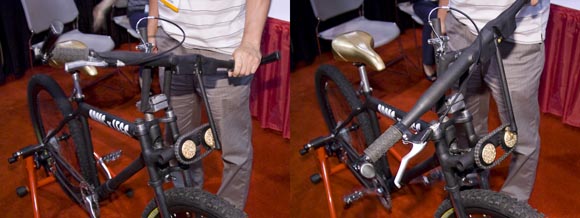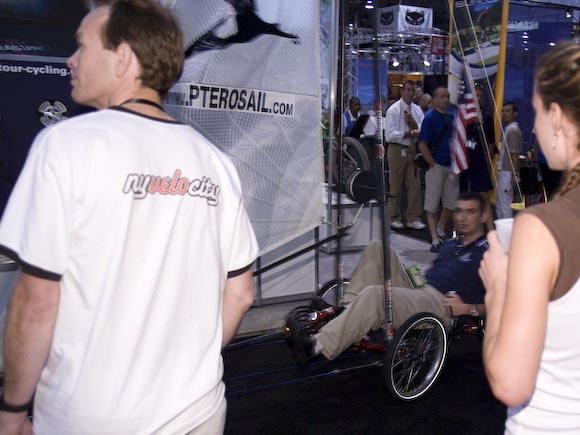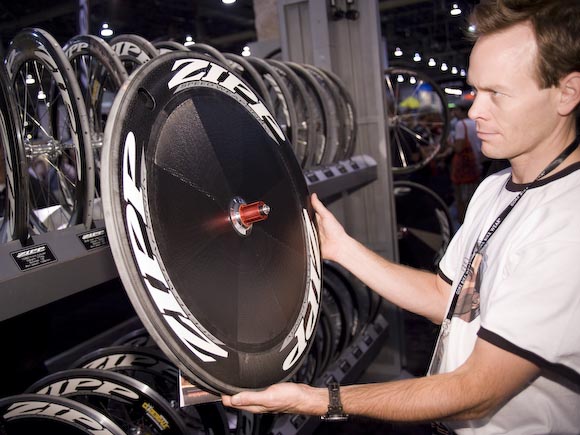If you’re like me, i.e., weak of leg, you might cruise the Sands floor looking for a little boost. I’m always open to ways of getting faster without that doing that stupid thing called training.
I could get a motorized hub…

…or a handlebar drive…

But I have toothpicks for arms, and I like having teeth, so maybe a sail is better.

What about a wheel that’s a sail? Oh heck, let’s stop beating around the bush. The Zipp Sub 9 Disc is making quite a splash, with its claim that it will provide 80 grams of thrust with a 15 degree headwind.
The whole project began with a clincher disc, a wheel Zipp never wanted to build. Zipp only wanted to build high performance discs, and they felt a clincher disc was a bit of an oxymoron. But their dealers kept telling them they could sell lots and lots of clincher discs, so they relented. The thing is, they couldn’t just slap an aluminum rim onto their tubular disc – it wasn’t built for that. So a bulge was added to bridge the rim and the disc for strength, comfort, and to maintain laminar flow longer than a flat disc.

<i>Schmalz eyeballing disc wheel = dog staring at a radio.</i>
The engineers got a pleasant surprise when they took the clincher disc to the San Diego LSWT. The drag numbers dropped as the wheel was rotated on the mount, dipping below zero when the wheel hit 15 degrees. (I’m pretty sure this is just the second instance of <a href=”/files/old/pictures/image/tturns35.jpg”>thrust</a> ever recorded in a wind tunnel.) Clearly, a tubular version had to be made. The Zipp guys returned to the tunnel with more prototypes to optimize the bulge shape, finally arriving at the profile of the Sub 9.
So, how skeptical should we be? Obviously, sailboats can sail into the wind, so it’s not impossible to generate thrust into a headwind. But sails are asymmetrical, forcing air to travel faster over one side than the other. The resultant difference in pressure creates lift. On a sailboat this lift force will be at an angle to the ship’s orientation, but the keel resists the lateral component of the lift force, allowing the boat to move forward. On a bike the wheels will act as the keel.
However, the Sub 9, unlike a sail, is symmetrical. The only way the Sub 9 can generate lift is if it resembles a symmetrical airfoil at an increased angle of attack. This is where Zipp’s claims of improved laminar flow makes sense. By keeping the wind attached to the wheel longer, the wheel can operate like an airfoil with fast moving air above it instead of turbulent stalled air.

The wheel is acting like an airfoil traveling forward at a 15 degree angle of attack. The black arrow is the lift force. The lateral component (blue arrow) is negated by the wheels rolling on the ground, leaving only the red, forward thrust. Presumably other disc wheels don’t generate lift because the airflow separates, putting it in a stall.
I’m hoping to get my hands on a test unit soon, so look for another Acme inspired test.

that diagram looks dirty.
natural.
i predict many a bulge at next year’s floyd TT.
unrelated, but jeez, could that scottish guy on cycling.tv have sounded any more bored with the finish of the world champs RR? just turned it on and figured there were hours to go, based on the tone of his voice, but then i heard, “ok, well, 2k to go…”
dude on the pterosail is checking out the Hotness
Maybe he’s checking out Andy and his big lens.
Barriers are up. There will be no Floyd TT.
Would there be drag on a 15o tailwind???
I guess so, but then you’re talking about a 45-50mph wind, in which case, a little drag is the least of your problems.
After factoring in your actual ground speed, you almost never have any sort of tailwind. Unless the wind is really really fast. Like about 35 mph.
What’s the point of all this stuff for local racers? If you can’t compete on your own strength forget about it. While this stuff will do you less harm than drugs the motivation is the same. Compete but most of all have fun.
I like science? It’s just kinda cool for its own sake. If someone’s going to build a wheel, I applaud them for building the best possible wheel. Doesn’t mean I’m going to buy it.
that’s exactly what fuentes would have said. “i just like 49.9999% crit levels for their own sake.” slippery slope, shen.
4:34, are you suggesting that only certain people should try? That we should train well, eat well, but deliberately neglect equipment advantages?
And “If you can’t compete on your own strength…” — are you stupid? Or do you expect us to be?
what would be wrong about having equipment standards that create an equal playing field and greatly reduce costs. A competitve sport open to more people. Is the sport about competition, fun and fitness or an obsession to spare no expense to cut a 2 secs off your time?
is that the rider is far and away the largest component of drag. the equipment advantage can help a little, but it’s not going to put you at a severe disadvantage if you don’t have it. tape your helmet vents if you have gear inferiority issues.
You mean the bulge shape that Steve Hed patented and the design Zipp paid Hed for the rights to use?
the one that’s not on Hed or Bontrager wheels?
Is that a bulge near the rim or are you just happy to see me?
ok, so when will Gabe have this available to rent? i want to use it fro c/x season.
Best way to test those disks – tie them to your arms and jump off a large building to see if they really generate lift. Now THATS science.
to tape up the vents in the helmet etc. is making me feel ashamed. There was Matti Helminen – 16th (Finland), 2.32 behind Cancellara on an oldish Litespeed with the most funny looking aero helmet and many other riders in the Worlds TT without shoe covers or any of these fancy equipment but go to Silvermine TT and you will see equipment that these pro’s from poorer countries can only dream of and then they will seriously kick our asses too. No more equipment for me thanks. If i can’t do it with good honest training then that’s it. I don’t even think all this shit makes such a big difference anyway but I do know that 5 lbs off my butt and some good interval training can make a difference.
Bontrager has a similar shape on their Aeolus disc wheel, but the bulge is smaller…maybe they were on to something but didn’t push far enough. they certainly didn’t sell the science as hard as Zipp is.
I see these drag angle numbers all the time, but in the field how often do they occur? 40kTT on an average variable wind direction day, how much of that would be into a 15 degree wind for this lift to matter? I get the science, I certainly get the marketing behind a claim like this, but, how rare is that perfect lift creating situation and will this product add speed in the long run? What are the numbers on the disc in a straight line or at 10 degrees? bulge faster or slower than a traditional dics???
Can’t help it:
“…but the bulge is smaller …they…didn’t push far enough.”
“… as hard as Zipp is.”
Is Zipp still a site sponsor?
I did say you should be skeptical, and I would like to verify those claims independently. AND, I did say I wouldn’t necessarily buy it. Actually, I’m pretty sure I can’t afford it.
do you really want poor, underemployed people mucking up our races and kicking our asses? Be careful what you wish for …
Who wants to buy a TT bike?
http://www.velocitynation.com/classifieds_detail.aspx?Adid=38
poor, underemployed people do kick your asses. they are called Cat 1s and 2s.
haha. So true. Good call.
haha. So true. Good call.
Who wants to buy a TT bike?
http://www.velocitynation.com/classifieds_detail.aspx?Adid=38
poor, underemployed people do kick your asses. they are called Cat 1s and 2s.
Is Zipp still a site sponsor?
I did say you should be skeptical, and I would like to verify those claims independently. AND, I did say I wouldn’t necessarily buy it. Actually, I’m pretty sure I can’t afford it.
do you really want poor, underemployed people mucking up our races and kicking our asses? Be careful what you wish for …
Can’t help it:
“…but the bulge is smaller …they…didn’t push far enough.”
“… as hard as Zipp is.”
Bontrager has a similar shape on their Aeolus disc wheel, but the bulge is smaller…maybe they were on to something but didn’t push far enough. they certainly didn’t sell the science as hard as Zipp is.
I see these drag angle numbers all the time, but in the field how often do they occur? 40kTT on an average variable wind direction day, how much of that would be into a 15 degree wind for this lift to matter? I get the science, I certainly get the marketing behind a claim like this, but, how rare is that perfect lift creating situation and will this product add speed in the long run? What are the numbers on the disc in a straight line or at 10 degrees? bulge faster or slower than a traditional dics???
to tape up the vents in the helmet etc. is making me feel ashamed. There was Matti Helminen – 16th (Finland), 2.32 behind Cancellara on an oldish Litespeed with the most funny looking aero helmet and many other riders in the Worlds TT without shoe covers or any of these fancy equipment but go to Silvermine TT and you will see equipment that these pro’s from poorer countries can only dream of and then they will seriously kick our asses too. No more equipment for me thanks. If i can’t do it with good honest training then that’s it. I don’t even think all this shit makes such a big difference anyway but I do know that 5 lbs off my butt and some good interval training can make a difference.
Best way to test those disks – tie them to your arms and jump off a large building to see if they really generate lift. Now THATS science.
is that the rider is far and away the largest component of drag. the equipment advantage can help a little, but it’s not going to put you at a severe disadvantage if you don’t have it. tape your helmet vents if you have gear inferiority issues.
You mean the bulge shape that Steve Hed patented and the design Zipp paid Hed for the rights to use?
the one that’s not on Hed or Bontrager wheels?
Is that a bulge near the rim or are you just happy to see me?
ok, so when will Gabe have this available to rent? i want to use it fro c/x season.
what would be wrong about having equipment standards that create an equal playing field and greatly reduce costs. A competitve sport open to more people. Is the sport about competition, fun and fitness or an obsession to spare no expense to cut a 2 secs off your time?
4:34, are you suggesting that only certain people should try? That we should train well, eat well, but deliberately neglect equipment advantages?
And “If you can’t compete on your own strength…” — are you stupid? Or do you expect us to be?
that’s exactly what fuentes would have said. “i just like 49.9999% crit levels for their own sake.” slippery slope, shen.
I like science? It’s just kinda cool for its own sake. If someone’s going to build a wheel, I applaud them for building the best possible wheel. Doesn’t mean I’m going to buy it.
What’s the point of all this stuff for local racers? If you can’t compete on your own strength forget about it. While this stuff will do you less harm than drugs the motivation is the same. Compete but most of all have fun.
After factoring in your actual ground speed, you almost never have any sort of tailwind. Unless the wind is really really fast. Like about 35 mph.
Would there be drag on a 15o tailwind???
I guess so, but then you’re talking about a 45-50mph wind, in which case, a little drag is the least of your problems.
Maybe he’s checking out Andy and his big lens.
Barriers are up. There will be no Floyd TT.
dude on the pterosail is checking out the Hotness
that diagram looks dirty.
natural.
i predict many a bulge at next year’s floyd TT.
unrelated, but jeez, could that scottish guy on cycling.tv have sounded any more bored with the finish of the world champs RR? just turned it on and figured there were hours to go, based on the tone of his voice, but then i heard, “ok, well, 2k to go…”
There is a flaw in the diagram. Even though the airflow is not stalled, there will still be a growing boundary layer, causing a so-called form drag. There will also be friction drag. These drag components will counteract the thrust (the red arrow).
Look at the wheel as a wing. The black arrow is the wing’s lift, drawn perpendicular to the air free-stream. But, every wing also has an aerodynamic drag which is drawn backwards, parallel to the free-stream. For the diagram to make sense, that should have been shown too. The total aerodynamic force is the sum of the lift and the drag. If the lift to drag ratio is high, the total force will point slightly forward in the direction of the wheel’s movement, i.e. there’s a thrust. If the lift to drag ratio is low, the total force will point backwards, i.e. there’s a drag.
So, what Zipp have done is to create a wheel that, if you look at it as a wing, has a very good (i.e. high) lift to drag ratio.
I see your point, yes, I did neglect the drag. I guess for a wing you don’t mind the drag as long as it’s lifting you up, whereas with a sail, you’re more interested in having more thrust than drag. Most of the lift force gets erased by the keel or the wheel in this case.
too confusing, had to go watch re-runs of me in kung fu to even begin to understand all of this.
–kwai chang caine